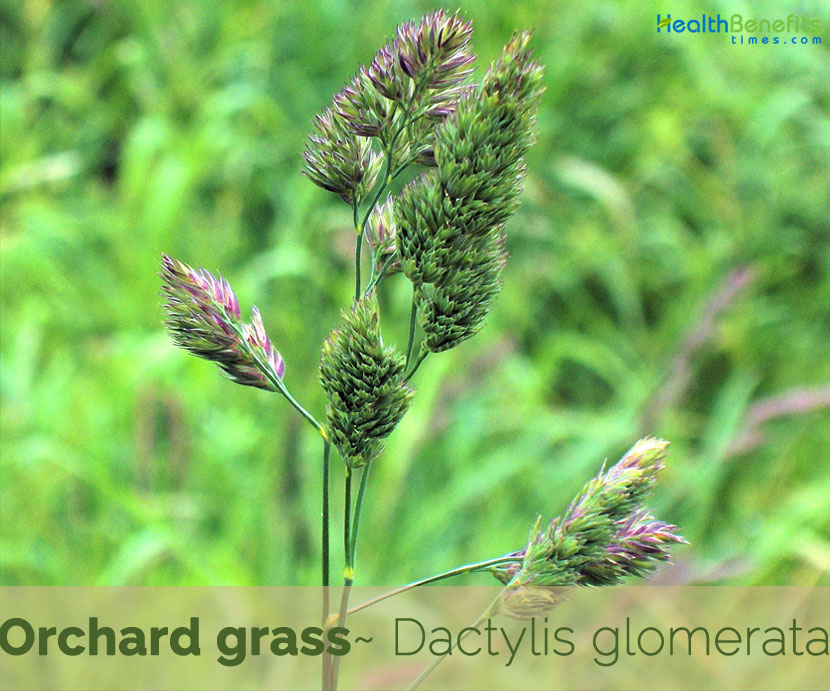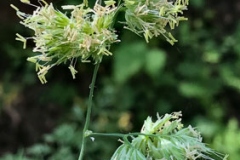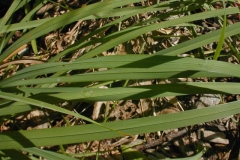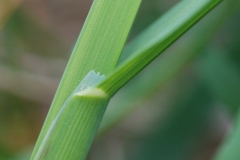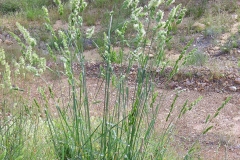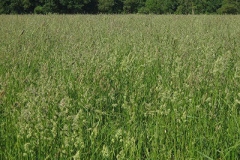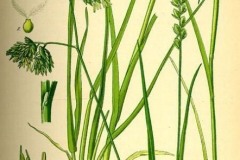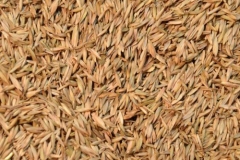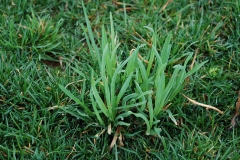Barnyard grass, cat’s grass, cock’s foot, cocksfoot, cocksfoot grass, cockspur, orchard grass, orchardgrass, cocksfoot, hardgrass, rough cocksfoot, Cat grass, Slender Cock’s-foot and Ascherson’s orchardgrass are some of the popular common names of the plant. Orchardgrass is shade tolerant and is common in numerous shady areas such as orchards, hence its common name. The alternate common name, ‘cocksfoot’, is in reference to the shape of the flower head, with its long lower flowering branches that stick out to the side during bloom. The species name, glomerata, means ‘gathered in bunches’, referring to the dense, irregularly rounded flower clusters.
Orchard Grass Facts
| Orchard grass Quick Facts | |
|---|---|
| Name: | Orchard grass |
| Scientific Name: | Dactylis glomerata |
| Origin | Europe, temperate Asia, and northern Africa |
| Shapes | Seed head is dense and spike-like in appearance when it first emerges. With maturity, it becomes open and branched. |
| Health benefits | Beneficial for treating tumors, kidney and bladder ailments. |
| Name | Orchard grass |
|---|---|
| Scientific Name | Dactylis glomerata |
| Native | Northern Africa (i.e. Algeria, Egypt, Libya, Morocco and Tunisia), Europe (i.e. Denmark, Finland, Ireland, Norway, Sweden, UK, Austria, Belgium, Czechoslovakia, Germany, Hungary, the Netherlands, Poland, Switzerland, Belarus, Estonia, Latvia, Lithuania, Moldova, Russia, Ukraine, Bulgaria, Italy, Romania, Yugoslavia, France, Portugal and Spain), western Asia, Mongolia, Pakistan and northern India |
| Common Names | Barnyard grass, cat’s grass, cock’s foot, cocksfoot, cocksfoot grass, cockspur, orchard grass, orchardgrass, cocksfoot, hardgrass, rough cocksfoot, Cat grass, Slender Cock’s-foot, Ascherson’s orchardgrass |
| Name in Other Languages | Afrikaans: Boord gras Albanian: Telishi, bari i kopshtit Amharic: Yefirafirē sari (የፍራፍሬ ሣር-) Arabic: Iisbaeiat eunqudia (إصبعية عنقودية), bistan aleashb (بستان العشب) Armenian: Voznakhot (ոզնախոտ), ptghatu ayginer (պտղատու այգիներ) Azerbaijani: Meyvə bağı Basque: Alka-belar Belarusian: Kupkoŭka sbornaya (Купкоўка зборная) Bengali: Bāgānēra ghāsa (বাগানের ঘাস) Breton: Geot gallek Bulgarian: Yezhova glavitsa (ежова главица), obiknovena glavitsa (обикновена главица), sborna glavitsa (сборна главица), ovoshtna treva (овощна трева) Burmese: Hkyaan myaat (ခြံမြက်) Catalan: Dactyl, Cucurulles, Dàctil, Fenal, Fenàs mascle Chinese: Yā máo (鸭茅), Guǒyuán cǎo (果园草) Croatian: Cvorasta oštrica, voćna trava Czech: Srha říznačka, srha laločnatá, ovocná tráva Danish: Hundegræs, Almindelig hundegræs, frugtplantagegræs Dutch: Gewone kropaar, kropaar, boomgaard gras English: Cocksfoot, hardgrass, rough cocksfoot, orchardgrass, Cat grass, Slender Cock’s-foot, Barnyard grass, Cocksfoot grass, Cockspur, Ascherson’s orchardgrass Esperanto: Gardeno Estonian: Harilik kerahein, viljapuuaia rohi Finnish: Koiranheinä, hedelmätarhan ruoho French: Chiendent à bossettes, dactyle aggloméré, dactyle pelotonné, herbe des vergers, patte de lièvre, pied de poule, Dactyle vulgaire, Gramen pelotonné, herbe du verger Galician: Dactyle pelotonné Georgian: Satitura (სათითურა), baghis balakhi (ბაღის ბალახი) German: Gemeines Knaulgras, gemeines Knäuelgras, gewöhnliches Knaulgras, gewöhnliches Knäuelgras, Knäuelgras, Wiesenknäuelgras, Knäuelgras, Wiesen-Knäuelgras, Obstgartengras Greek: Daktylída (δακτυλίδα), chórto oporóna (χόρτο οπωρώνα) Gujarati: Bāga ghāsa (બાગ ઘાસ) Hausa: Ciyawar orchard Hebrew: Tzibboret heharim, צִבֹּרֶת הֶהָרִים, ציבורת ההרים Hindi: Ghaas ghaas (घास घास) Hungarian: Csomós ebír , gyümölcsös fű Icelandic: Axhnoðapuntur, Orchard gras Indonesian: Rumput kebun Irish: Féar úllord Italian: Erba mazzolina, erba mazzolina commune, pannocchina, Dattile, erba del frutteto Japanese: Kamogaya (カモガヤ), Ōchādogurasu (オーチャードグラス) Javanese: Suket ing kebon Kannada: Haṇṇina hullu (ಹಣ್ಣಿನ ಹುಲ್ಲು) Kazakh: Kädimgi tarğaqşöp (Кәдімгі тарғақшөп), كادىمگى تارعاقشوپ, baqşa şöpteri (бақша шөптері) Kirghiz: Aksokto (Аксокто) Korean: Gwasuwon jandi (과수원 잔디) Kurdish: Giyayê dare Lao: Orchard ja Latin: Herba pomarii claudite Latvian: Parastā kamolzāle, augļu dārza zāle Lithuanian: Paprastoji šunažolė, sodo žolė Macedonian: Yezhevka (ежевка), ovošna treva (овошна трева) Malagasy: Ahitra Malay: Rumput dusun Malayalam: Pūntēāṭṭa pull (പൂന്തോട്ട പുല്ല്) Maltese: Haxix tal-ġardina Marathi: Bāga gavata (बाग गवत) Mongolian: Tsetserlegiin övs (цэцэрлэгийн өвс) Nepali: Bagaicā ghām̐sa (बगैचा घाँस) Northern sami: Beatnatrávda Norwegian: Hundegras, Hund-grass, frukthage gress Occitan: Grosso-testo, Pè de lèbre, Pèd-de-lèbre Oriya: ବଗିଚା ଘାସ | Persian: علف باغ, چمنزار باغ Polish: Kupkówka pospolita, rżniączka pospolita, trawa sadowni Portuguese: Dáctila, dáctilo, dáctilo-comum, dáctilo-dos-lameiros, erva-dos-combros, panasco, panasco-das-areias, panasco-das-moitas, panasco-de-folhas-estreitas, pé-de-galo, Capim-dos-pomares, grama de pomar Punjabi: Bagīcā ghāha (ਬਗੀਚਾ ਘਾਹ) Romanian: Golomăţ, iarba de livadă Russian: Yezha obyknovennaya (ежа обыкновенная), yezha sbornaya (ежа сборная), sadovaya trava (садовая трава) Serbian: Ježevica (јежевица), Јеževica, voćnjak trave (воћњак траве) Sindhi: باغن جي گھاس Sinhala: Paḷaturu vatu taṇakoḷa (පළතුරු වතු තණකොළ) Slovak: Reznačka laločnatá Slovene: Navadna pasja trava, sadovnjak Spanish: Dáctilo, dáctilo aglomerado, dáctilo apelotonado, dáctilo ramoso, lastón, pasto ovillo, triguera, pasto azul orchoro, pasto orchoro, grama en jopillos, Jopillo, Rata trepadora, pasto ovillo, zacate del huerto, hierba de huerto Sundanese: Jukut dusun Swedish: Hundäxing, Koiranheinä, Vanlig hundäxing, fruktträdgårdsgräs Tajik: Alafi ʙoƣī (алафи боғӣ) Tamil: Paḻattōṭṭa pāṭal (பழத்தோட்ட புல்), Paḻattōṭṭa pul Telugu: Ārcarḍ gaḍḍi (ఆర్చర్డ్ గడ్డి) Thai: H̄ỵ̂ā s̄wn p̄hl mị̂ (หญ้าสวนผลไม้) Turkish: Meyve bahçesi Ukrainian: Hryastytsya zbirna (грястиця збірна), fruktova trava (фруктова трава) Upper Sorbian: Lěsny sukač Urdu: باگ گھاس Uzbek: Oqsoʻxta, mevali o’t Vietnamese: Vườn cây ăn trái Walloon: Rexhe waide Welsh: Troed y ceiliog, glaswellt perllan Zulu: Utshani bezithelo |
| Plant Growth Habit | Coarse, clump-forming, cool-season tall growing, perennial grass |
| Growing Climates | Grass and heathland, forests, riparian habitats, freshwater wetlands, coastal areas, meadows, pastures, sand dunes, disturbed sites, roadsides, rough grassland, fields, savannas, woodland borders, orchards, thickets, fence rows, powerline clearances in wooded areas and miscellaneous waste area |
| Soil | Performs well on different textured soils ranging from clay to gravely loams and on shallow to deep soils. It does not grow well in saline soils and areas with high water tables |
| Plant Size | 1.4 to 4 feet (0.5-1.2 m ) tall |
| Root | Extensive fibrous root system but no stolons and rarely have short rhizomes |
| Culms | Light green, terete, and glabrous; later they become straw-colored |
| Stem | Stems are flattened and are either erect or bend abruptly at the base |
| Leaf | Leaves of both fertile and infertile shoots have a similar appearance. Their blades are up to 10″ long and 1/3″ (8 mm.) across; they are green and hairless. The leaf blades of infertile shoots spread outward and remain low |
| Flowering season | June to September |
| Flower | Inflorescence consists of a panicle of spikelets; the branching pattern of this panicle tends to occur along a 2-dimensional plane. The panicle is up to 10 inches long and 5 inches across, consisting of an erect rachis and short lateral branches |
| Fruit Shape & Size | Seed head is dense and spike-like in appearance when it first emerges. With maturity, it becomes open and branched |
| Seed | Seeds are very small, narrow, pointed about 1/3 inch long |
| Propagation | By seed or by divisions |
| Season | July to September |
| Traditional Uses |
|
| Precautions |
|
Plant Description
Orchard grass is a coarse, clump-forming, cool-season, tall growing, perennial grass that normally grows about 1.4 to 4 feet (0.5-1.2 m) tall. The plant is found growing in grass and heath land, forests, riparian habitats, freshwater wetlands, coastal areas, meadows, pastures, sand dunes, disturbed sites, roadsides, rough grassland, fields, savannas, woodland borders, orchards, thickets, fence rows, powerline clearances in wooded areas and miscellaneous waste area. The plant performs well on different textured soils ranging from clay to gravely loams and on shallow to deep soils. It does not grow well in saline soils and areas with high water tables. The plants have extensive fibrous root system but no stolons and rarely have short rhizomes. Stems are flattened and are either erect or bend abruptly at the base. Culms are light green, terete, and glabrous; later they become straw-colored.
Leaves
The leaves of both fertile and infertile shoots have a similar appearance. Their blades can be 3 to 12 inches long (or more) and 1/8 to 1/3 inch wide. They are light green to dark blue-green and hairless somewhat rough on the upper and lower surfaces and margins, and sharply folded (V-shaped in cross-section). The leaf blades of infertile shoots spread outward and remain low, while the blades of alternate leaves on fertile shoots are more arching. Leaf sheaths are light green, hairless, and open toward their apices and have longitudinal veins. The ligule (projection inside on the top of the sheath) is membranous, finely toothed, rounded to pointed and relatively long (1/6 to 1/3 inch long). Auricles (appendages at the top of the sheath) are absent.
Flower
The inflorescence consists of a panicle of spikelets; the branching pattern of this panicle tends to occur along a 2-dimensional plane. The panicle is up to 10 inches long and 5 inches across, consisting of an erect rachis and short lateral branches (only 1 lateral branch per node). Latter are stiff, straight, spreading to nearly erect, and few in number. Lateral branches have dense tufts of spikelets toward their tips, otherwise they are naked. The rachis also terminates in dense tufts of spikelets.
Each spikelet consists of a dense tuft of 3-7 lemmas and their perfect florets; there is a pair of sterile glumes at the bottom. The spikelets are whitish green while their florets are blooming, but they later become light tan to brown. The glumes are linear-lanceolate, keeled, and unequal in size; the shorter glume of a pair is about 4-5 mm. in length, while the longer glume is about 5-6 mm. in length. The lemmas are linear-lanceolate and ciliate along their keels; they are about 5-8 mm. in length. In each spikelet, the upper lemmas tend to be shorter than the lower lemmas. Each floret has a pair of white plumose stigmata and 3 stamens with large white anthers. The blooming period occurs from June to September, lasting about 1-2 weeks for a colony of plants.
Fruit
The seed head is dense and spike-like in appearance when it first emerges. With maturity, it becomes open and branched. Seeds are very small, narrow, pointed about 1/3 inch long with 95,000 to 1,300,000 seeds/kg. They are food sources for caterpillars like the gatekeeper and meadow brown; while the seeds are eaten by finches and gamebirds.
Prevention and Control
Due to the variable regulations around (de)registration of pesticides, your national list of registered pesticides or relevant authority should be consulted to determine which products are legally allowed for use in your country when considering chemical control. Pesticides should always be used in a lawful manner, consistent with the product’s label.
Physical/Mechanical Control
Beddows (1959) says that D. glomerata can easily be controlled by ploughing, and that it does not survive heavy trampling by livestock. Muyt (2001) says that plants can be dug out but that the crown must be removed to prevent regrowth. Where plants are in seed he suggests cutting and bagging the stems before removing the rest of the plant. Muyt (2001) also says that stands can be slashed regularly during the main growing season to limit seed production. When a weed in turfgrass it can eventually be eliminated by close mowing (Hathaway et al., 2004).
Biological Control
Although a few insect species seem to be confined to D. glomerata (Beddows, 1959) there has never been any interest in using any of these for biological control: the species is so-long established and so valuable in many places that this would be impractical.
Chemical Control
Muyt (2001) says that plants can be treated with non-selective herbicides like glyphosate or grass-selective herbicides like fluazifop-butyl, but follow-up treatment is needed to control seedlings and surviving plants.
Few Important Facts
- Having a deep root system, the plant is also useful for checking soil erosion.
- The plant can be grown for biomass, annual productivity ranges from 2 to 37 tons per hectare.
- It is widely used as a pasture grass and also to improve forage production on rangelands.
- Orchard grass has 487,000 seeds per pound.
References:
https://www.itis.gov/servlet/SingleRpt/SingleRpt?search_topic=TSN&search_value=193446#null
http://www.hear.org/pier/species/dactylis_glomerata.htm
https://npgsweb.ars-grin.gov/gringlobal/taxon/taxonomydetail?id=13114
https://pfaf.org/user/plant.aspx?latinname=Dactylis+glomerata
http://www.floracatalana.net/dactylis-glomerata-l-
https://www.cabi.org/isc/datasheet/17618
https://plants.usda.gov/core/profile?symbol=DAGL
https://en.wikipedia.org/wiki/Dactylis_glomerata
https://www.cal-ipc.org/plants/profile/dactylis-glomerata-profile/
http://www.theplantlist.org/tpl1.1/record/kew-406640
https://www.fs.fed.us/database/feis/plants/graminoid/dacglo/all.html
https://gd.eppo.int/taxon/DACGL
https://www.hort.purdue.edu/newcrop/duke_energy/Dactylis_glomerata.html


